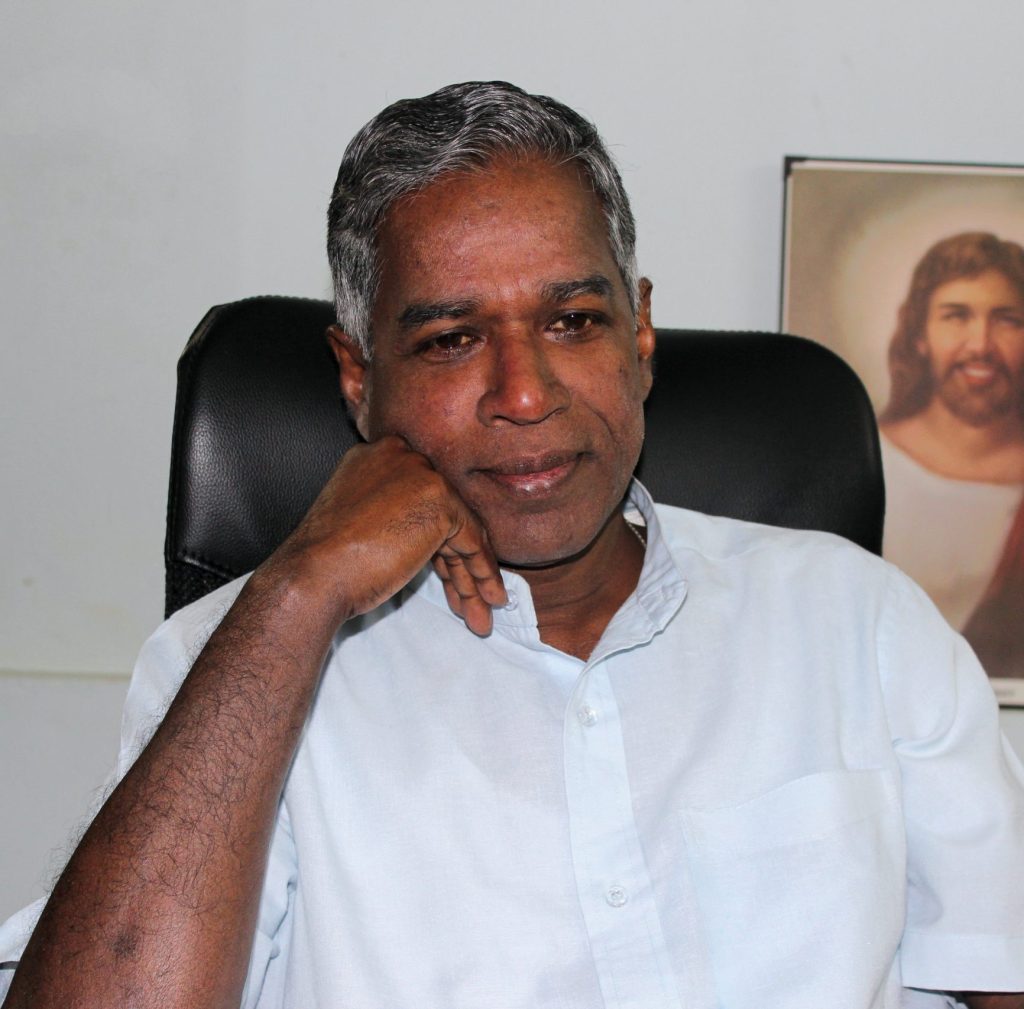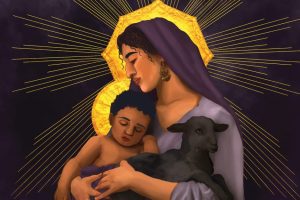Indian theologian Jacob Parappally believes that the Western church is too preoccupied with dogmas and doctrines.

It’s not that dogma isn’t important, explains Parappally, author of the new book Christ Without Borders (Orbis Books). But so much of Catholic doctrine relies on a Greco-Roman worldview to explain the Christian mysteries. And this leaves out people who may not share a European perspective—including Catholics in India.
Instead of focusing on historical doctrine, Parappally says, religious language and dogmas should be flexible, adapting to evolving religious consciousness across cultures. He suggests that there may be alternative ways to think about Christ that are more universal.
One of these ways, according to Parappally, is to understand or interpret Christ through the lens of Indian philosophy, specifically through Indian philosophical teachings about nondualism. “We have always explained dogmas and doctrines only through Greek categories of thought,” Parappally says. “But there’s a whole section of Indian philosophy useful for explaining the Christian mysteries. Both worldviews can be complementary in explaining the mystery of Christ.”
Such teachings give new insight into Christ’s human and divine natures, allowing us to understand his humanity and divinity as layers of the same complete person rather than as separate aspects of Jesus coexisting in one body. Such a perspective not only gives new expansive views into Christ but also provides new insights into liberation theology and care for the poor.
What was the Council of Chalcedon?
The Council of Chalcedon was called in 451 to solve the problem of how Jesus Christ could be both human and divine at the same time. It came about within the context of two different theologies: Alexandrian theology stressed the divinity of Christ, and Antiochian Christology stressed the humanity of Christ.
Both were very extreme positions. A belief in Christ’s divinity was thrust to the extreme in the views of a bishop named Eutyches, who believed that before the incarnation, Jesus existed as fully divine. During the incarnation, his divinity subsumed any humanity in his person, so that Christ only had one nature—his divine nature.
The other extreme, focusing only on the humanity of Christ, can be seen in the ideas of Nestorius, who believed that Mary was the mother of Jesus but not the mother of God. He said that if she was the mother of God, she would be a goddess, like Artemis or Isis. Since she is not a goddess herself, she must be only the mother of Jesus in his humanity.
Both extremes were seen as contradicting the apostolic faith, which teaches that Jesus is both human and divine. The Council of Chalcedon was called to arbitrate. The Council affirmed that Jesus Christ is both true God and true human. In Jesus Christ, both human and divine nature coexist. Without confusion, without division, without change, and without mixture. Anyone who believed otherwise was deemed heretical.
Is this teaching—that Jesus has two different but coexisting natures—an adequate and complete understanding of Christ?
It is a very Greek way of thinking about Christ—this idea of one person and two natures. The Council of Chalcedon puts in place this assumption that the mysteries of Christianity can only be understood through Greek categories of thought.
As a result, the church articulated who Jesus Christ is in dialogue with Judaism and the Greco-Roman world, but this theology, embedded in this Greek philosophy, was not meaningful to people from other cultures and other ways of understanding the world, for example to the Catholic Church in India.
You write in your book that following a literal orthodoxy is “lazy.” Can you explain what you mean by this?
When we repeat the dogmas and orthodoxy—like that taught in the Council of Chalcedon—we repeat without understanding what we are saying. We need dogmas and doctrines so that the people don’t start believing in superstition and go away from faith, but we should not become prisoners of dogmas. We should not make them idols.
First of all, the dogmas are formulated in the language of Greek philosophy. And this language is very clear, but that which is beyond human understanding cannot be put into such neat, clear language. That reduces the mystery of Christ into small formulas.
Then, we just get stuck. Orthodoxy comes to mean the ability to repeat the same dogmas. We repeat them, but do we understand them?
Catholics believe that scripture and tradition are the two main sources of theology. But I would say there is also a third one: 2,000 years of religious consciousness. Think of how people’s understanding of God has changed throughout scripture. In places God seems cruel, in other places God is so compassionate and loving, like a mother who never forgets her children. Theology must be able to take into account how religious consciousness changes. Religious language changes based on people’s religious consciousness and on the cultural context.
I tell people to be careful of religious language. Religious language is descriptive and evocative, but it’s also metaphorical. And it’s also mythical. Andrew Greeley writes that myth is an approximate expression of truth because no language can adequately articulate the truth of the mystery of God: We need the approximate expressions.
That’s why we should rethink dogma: Dogmas are necessary, but they are also only approximate. Our religious thinking must go beyond that.
Are there other ways to understand the humanity and divinity of Christ beyond the dogma taught by the Council of Chalcedon?
Pope Benedict said that Greek philosophy is a gift to the church. And it is true that Greek philosophy brought a lot of clarity into the Christian understanding. But I would argue that Indian philosophy is also a grace, and that it can explain certain aspects of theology much better.
Brahmabandhab Upadhyaya is an Indian theologian who converted from Hinduism to Catholicism. In the 1880s, almost 14 centuries after Chalcedon, he interpreted this Chalcedonian affirmation about Christ’s nature not through Greek philosophy, but through Indian philosophy. He argued that the latter can better explain the humanity and divinity of Christ. Namely, that instead of Jesus having two natures, divine and human, that never combine and that coexist, in Christ humanity and divinity are united as one.
Upadhyaya argued that instead of using Aristotelian philosophy to explain Christian theology, like Thomas Aquinas did, using Indian philosophy—especially the concept of Sankara, or nondualism—can better explain Christian doctrine.
Greek philosophy or Western philosophy is analytical and based on the principle of contradiction. It is the basis of analytical thinking. A chair and a table are two separate things, and they cannot be the same. But Indian philosophy stresses the principal identity, instead: Both chair and table are made of wood. Applying this to the understanding of Christ’s divinity and humanity, which are distinct but not separate, Upadhyaya explains the unity of divine and human nature in the person of Jesus Christ.
He said that, according to Indian anthropology, human beings are composed of five layers: the physical, vital, mental, intellectual, and spiritual. All of these layers, or sheaths, combine to make one human being. And the human being, the individual self—the ego or the consciousness—is the one who controls all these five layers. And Jesus, like any other human, has these same five layers, but but they are governed by the ultimate person, the Logos, the second person in the Trinity. So Jesus has human thinking, freedom, and consciousness, but the ultimate subject of his being is the Logos instead of the ego.
“We need dogmas and doctrines so that the people don’t start believing in superstition and go away from faith, but we should not become prisoners of dogmas. We should not make them idols.”
This way is different from the Chalcedonian formula of two dual natures. That is a static expression of the reality of Christ. But Upadhyaya’s articulation of the unity of divinity and humanity in Christ is very dynamic and positive. You can think of Christ very differently if you think of him having the same type of intellectual thinking and freedom as any of us, though he is the second person of the Trinity.
Does this affect your view of the incarnation?
It is important to recognize that there are many different religions within Hinduism. In Shaivism, or traditions that worship Shiva as the supreme God, there is no theology of incarnation. Robert Charles Zaehner, a British Jesuit who writes on Hinduism, says that their theology is very close to Christian ideas on grace, sin, and salvation, but there is no incarnation.
Meanwhile, in the Vaishnava tradition, which sees Vishnu as God, there are 10 incarnations of Vishnu. But this is entirely different from incarnation in the Christian tradition. The Bhagavad Gita says, “For the protection of the righteous and the destruction of the wicked, I [God] am born in every age.” In other words, Vishnu incarnates himself to destroy immoral criminals and reestablish order, or dharma.
This is totally different from Christian understandings of incarnation, where God becomes human one time for everyone. There is no repeated incarnation, and God does not come to destroy people but to destroy sin. In Vaishnava Hinduism, incarnations of God destroy evil people; in Christianity, the incarnation, Jesus Christ, destroys evil. As Irenaeus says, God becomes human that we may become divine. God does not destroy.
I agree with Origen, who said that incarnation is the wrong word to use. We should say hominization instead: God became human. God became truly human like you and me in order to redeem us and make us even more human.
Irenaeus says that humans are not created perfect; we are created for perfection. We have the capacity to become better and better and better. God became human to lead us to perfection. This beautiful idea was taken over by Augustinian theology, which has a very negative anthropology—Augustine believed that due to original sin, human beings are corrupt and dead. He said there was nothing good in human beings. In Augustine’s view, God sent his son into a miserable situation to save us. This is why we say during the Easter Vigil, “O happy fall of Adam; therefore, we have a savior.” Irenaeus would never have said this.
I think a better theology than this negative understanding of human beings is what Irenaeus and Origen taught: this hominization of the Word, the incarnation, is what makes us truly human. The incarnation in itself is salvific. We are saved by the very fact that God became human. But one has to freely accept it to make it reality in one’s life.
What does this mean for the importance of Jesus’ death and resurrection?
For me, the key to understanding theology lies in two things. The first is interrelatedness. We are all interrelated; there are no strangers. I’ve only known you for 10 minutes, but we are not strangers, we are connected. The good you do affects me, the evil I do affects you.
The second key is freedom. John’s gospel says that there’s only one sin: closing yourself against God. When you close yourself against God, you are in darkness. When you open yourself to God, you are in light, life, and truth. God respects our freedom to choose either way; God will not take that freedom away from us. Therefore, my salvation through the incarnation will not become reality unless I accept that in my freedom.
Jesus’ life, death, and resurrection are important in persuading me to accept that. That a very positive way of looking at God’s hominization or incarnation in the world and its meaning for humanity. Only through the resurrection of Jesus from the dead could I know that Jesus was God incarnate.
How can Indian philosophy deepen our understanding of theology more broadly?
There are various Indian and Hindu philosophies. But one helpful concept is Advaita, nonduality. Some people, both Indian and Western, have interpreted Advaita to mean that all of reality is one. But this is the wrong interpretation: non-duality means not two, but also not one. It’s a kind of understanding and vision that cannot be logically explained. God and human beings are not two, but they are also not one. God is God, human beings are human beings. They are distinct but not separate.
Advaita can also provide insights into the Trinity. The Father, Son, and Holy Spirit are not three, but they are also not one. They are distinct: The Father is not the Son, the Son is not the Spirit. But there is only one God: They are in communion. They are distinct but not separate. There is relationality between the persons of the Trinity and between God and humanity.
God cannot become human if there is no relationality between God and human beings that gives a basis for God becoming human. We are distinct from God but not separate from God. This is reflected in Pauline and Johannine theology. Paul says in Romans chapter 8, “Who will separate us from the love of Christ?” Objectively, no separation from God is possible but subjectively one can choose not to accept that relationship.
Because of this sense of nonduality Hindus have no problem keeping a picture of Jesus next to Vishnu, for example. They would say that the two are not separate but interrelated—everything is interrelated.
Spanish priest and interfaith scholar Raimon Panikkar describes a concept he calls cosmotheandrism—the idea that the cosmos (world), theos (God), and anthropos (humanity) are interconnected. According to cosmotheandrism, there is no God without the world and humanity. There is no world without human beings and God. All three are interrelated.
This idea isn’t limited to Indian philosophies; in Laudato Si’ (On Care for Our Common Home), Pope Francis speaks of the interrelatedness of all of creation. He quotes the Prayer of St. Francis, calling the sun and moon our brother and sister.
Does this type of Christology affect how we understand the historical person of Jesus?
Indian philosophical concepts such as Advaita encourage a more holistic, relational, and cosmic understanding of Christ. They invite us to see Jesus as not limited by historical or cultural boundaries but as a universal, cosmic presence. The incarnation was not just historical event but is an ongoing reality, affecting every aspect of creation and human existence.
The fact that the incarnation, or hominization of the Word, happened in human history is important. God entered into our history. God became a human being walking on Earth. This is very important for the Christian faith. This has so much importance; humans understand that we are not useless but precious, that God takes us seriously.
But in the recent past we have gone to the other extreme and limited Jesus to history. In the last century, many theologians wrote a history or biography of Jesus to affirm the historical reality of Christ. That’s why I chose to write this book, Christ Without Borders. Because Christ isn’t limited to history. Christ is the alpha and the omega, the cosmic Christ.
When teaching, I used to use the example of an hourglass. The top is wide space, then sand flows through a small neck, and the bottom is open again. That small neck is history; the Logos went into a small neck of history and then opened back up again. Christ cannot be limited by dogmas and doctrines; the incarnation has made us aware of that. As Colossians 1:15 says, “Jesus is the image of the invisible God, the firstborn of all creation. Everything is created in Him and through Him and for Him.” I used to say that he’s not just the alpha and omega, he’s the beta, delta, gamma, everything. He’s in all the letters.
This Christ can’t be limited by history or culture. One culture cannot hold him. Greco-Roman philosophy cannot hold him prisoner. The incarnation makes us aware that what we believe about God actually historically happened. It’s true. But we should not constrain Jesus to that history; we need to see this cosmic dimension as well. While the incarnation is important, we should not place such importance on the particular that the universal aspect is lost. This means that every culture can take and interpret Christ in their own culture and their own meaning.
A major thread throughout your book is that Jesus Christ came to offer liberation to those who are marginalized. How does Indian philosophy support this view of Christ?
Asian liberation theology is different from Latin American liberation theology, because most people in Latin America have a Christian background. But only 2–3 percent of the Asian continent is Christian; the society as a whole is multireligious. In addition, for many people in Asia, Jesus Christ is associated with colonial powers. To proclaim Jesus as the true liberator, we need to disentangle him from the legacy of colonialism and present him in a way that resonates with the oppressed and marginalized.
“The incarnation in itself is salvific. We are saved by the very fact that God became human.”
One of the Hindu ministers of Jawaharlal Nehru’s cabinet once told Christians, “Don’t bring another God to India; we have 33 crore (330 million) here.” He went on to say something that many people have failed to grasp: “If you believe that when human beings suffer, Jesus is still on the cross, then do something for these human beings.”
In other words, when human beings suffer, God suffers. This understanding is shared by theologians like Jürgen Moltmann and Japanese theologian Kazoh Kitamori. Moltmann said that if you say God cannot suffer, you deny the basic Christian affirmation that God is love. Love involves suffering.
What causes the greatest human suffering? When humans cannot unfold themselves as human beings—in situations of poverty and misery. This is what we see now in India due to globalization; the poor have become still poorer while the middle and upper classes enjoy comforts beyond what is available even in some Western countries.
Christians have a duty to reach out to those people who are suffering due to dehumanization and exploitation not just with charity but also to assist them in their struggle to become better humans and affirm their dignity. If God is suffering with these people, we all must act to end this suffering. Here again we must reflect on the principle of nonduality; God and those suffering are distinct but not separate. Nobody is outside the reality of Christ.
It is easy to do good out of charity—to see the poor as a stepping stone on the way to heaven. But that’s not what should inspire our work. We should become Christ to the other; I’m a manifestation of Christ, and I must be Christ to others. That’s a much harder spirituality.
This article also appears in the December 2024 issue of U.S. Catholic (Vol. 89, No. 12, pages 16-20). Click here to subscribe to the magazine.
Image: Unsplash/Dewang Gupta














Add comment